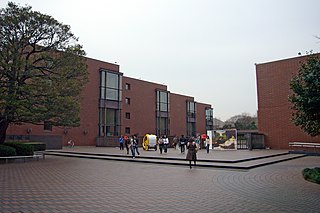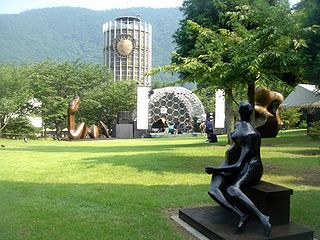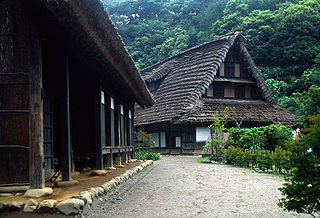Winners
Mika Aoki, ALIMO, ENERGY CENTER, Miyuki Inoue, Junpei Ueda, Masamitsu Katsu, Ryo Kaneko /Nobi-ANIKI, Takashi Kuniya, KOSUGE1-16, Yasuka Gotou, Hiroyuki Saitou, Junji Shiotsu, Kinichi Shinomiya, Motomasa Suzuki, Kanako Zuigyou, Shouko Takeuchi, Hideyuki Tanaka, Kenichirou Taniguchi, Kouta Nakamura, palla / Kazuhiko Kawahara, Yukihiro Yamagami, Youna Kousagiuguisu, Keita Yoshitani, Shou Yoshida, Makiko Tsuji, Kyun-Chome

Kanoko Okamoto, born Kano Ōnuki, was the pen-name of a Japanese author, tanka poet, and Buddhist scholar active during the Taishō and early Shōwa periods of Japan.

Abstraction-Création was a loose association of artists formed in Paris in 1931 to counteract the influence of the Surrealist group led by André Breton.

Tarō Okamoto was a Japanese artist, art theorist, and writer. He is particularly well known for his avant-garde paintings and public sculptures and murals, and for his theorization of traditional Japanese culture and avant-garde artistic practices.
Repast is a 1951 Japanese drama and shōshimin-eiga film directed by Mikio Naruse and starring Setsuko Hara. It is based on the final and unfinished novel by Fumiko Hayashi, and was the first in a series of adaptations of her work by the director.

The Tower of the Sun is a building created by Japanese artist Tarō Okamoto. It was known as the symbol of Expo '70 and currently is preserved and located in the Expo Commemoration Park in Suita, Osaka Prefecture, Japan. The tower has three faces on its front and back.

The Tokyo Metropolitan Art Museum is a museum of art located in Ueno Park, Tokyo, Japan. It is one of Japan's many museums which are supported by a prefectural government. The first public art museum in Japan, it opened in 1926 as the Tokyo Prefectural Art Museum and was renamed in 1943 after Tokyo became a metropolitan prefecture. The museum's current building was constructed in 1975 and designed by modernist architect Kunio Maekawa, remaining one his most well-known works today.
Okamoto is the 48th most common Japanese surname. Notable people with the surname include:

Taro Okamoto Museum of Art is an art museum located in Tama-ku, Kawasaki, Kanagawa, Japan. The Taro Okamoto Museum of Art mainly collects and preserves the works of Taro Okamoto and his parents, Kanoko and Ippei.
Nabeya Bi-tech Kaisha (鍋屋バイテック), also known as NBK, is a machine component parts manufacturer located in Seki, Gifu, Japan. The company's roots date to 1560, when it began as a metal foundry casting pots, tea kettles and temple bells.

The Hakone Open-Air Museum, opened in 1969, is Japan's first open-air museum. It is located in Hakone, Ashigarashimo District, Kanagawa Prefecture. Hosting over 1,000 pieces, it includes artworks by Pablo Picasso, Henry Moore, Taro Okamoto, Yasuo Mizui, Churyo Sato, Susumu Shingu, Constantin Brâncuși, Barbara Hepworth, Rokuzan Ogiwara, and Kōtarō Takamura, among others. About 120 sculptural works are on permanent display across the park. The museum is affiliated with the Fujisankei Communications Group media conglomerate.
Syoh Yoshida is a Japanese artist of the nihonga and ink painting genre.

Masayuki Okamoto is a former sumo wrestler and current professional wrestler from Chōyō, Kumamoto, Japan. In sumo, he used the shikonaKirinowaka Tarō, while in professional wrestling he is known by the ring name Shogun Okamoto.
Tenmyouya Hisashi is a Japanese contemporary artist.

Kiichi Okamoto was a Japanese painter best known for his illustrations for children.

Ikuta Ryokuchi Park is a park in Tama-ku, Kawasaki, Kanagawa Prefecture, Japan.
"Taro no To" is a 2011 dorama created by NHK. Directed by NHK employees Yoshihiko Nagikawa and Mitsuhiro Fukui, it stars Suzuki Matsuo as Okamoto Taro during his rise to fame and the construction of the Tower of the Sun in Osaka.
Kyun-Chome (キュンチョメ) is a Japanese artist unit based in Tokyo, made up of Nabuchi and Honma Eri. They emerged as an art unit after the 2011 Great East Japan Earthquake, and rose to prominence after winning the 17th Taro Okamoto Art Award in 2014.
The Mainichi Publishing Culture Award is an annual award given to distinguished literary works and activities in the sectors literature and art, humanities and social science, natural science, and encyclopedic work, plus a special award. It was founded in 1947 and is sponsored by the Mainichi Newspapers Co., the publishing house of the Mainichi Shimbun.
Yoru no Kai was a short-lived but highly influential art research and discussion group founded in early postwar Japan by two major theorists, Kiyoteru Hanada and Tarō Okamoto. While Hanada was a literary critic steeped in Marxist theory, Okamoto was an avant-garde artist well versed in Surrealism and ethnography in the mold of Bataille's College of Sociology. The group's tenet centers on its staunch rejection of "old familiar art" and earnest "exploration of a new art," as their manifesto radically called for: "We must destroy everything and create everything." Yoru no Kai offered an early important venue to discuss possible new directions in art and culture through public debates, member meetings, and publications. Although the group members were primarily those in literature, it embraced an interdisciplinary goal, collaborating with the artists collective Seiki no Kai and later recasting itself as Abangyarudo Geijutsu Kenkyūkai. In doing so, they exerted a significant influence that would be felt into the 1950s, as seen in the emergence of Reportage painters and the formation of Jikken Kōbō.
Kōji Kakinuma is a Japanese calligrapher.









